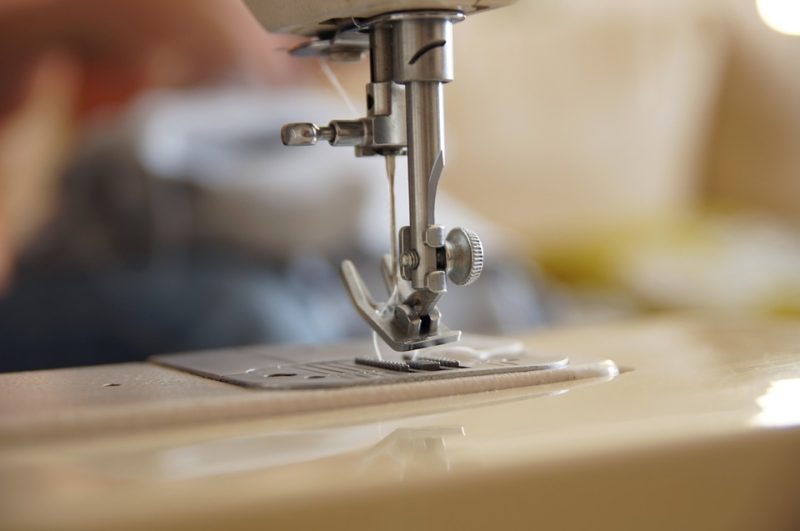If you want to learn how to tack sewing, here is a fast tutorial that you can do even as a beginner. We’ll also discuss its purpose. And, of course, you have to know the proper way of removing tack stitches.
Are you new to sewing in general? Then, please browse our blog for other discussions regarding sewing techniques. For example, you can learn what is baste in sewing, another term for making temporary stitches.

How To Tack In Sewing
- Thread the needle but don’t tie the thread end like you usually would
- Insert the needle through the fabric coming from the back
- Pull the needle so that you’ll have a long thread tail from the material
- Move the needle in a straight line going forward and then pierce through the fabric with all the thread
- What you’ll have is a long stitch on top of the fabric, then create a straight line again and have the needle through the back of the fabric
- Continue sewing as far as you need to tack with consistent stitch length
- Leave a long thread tail from the fabric
- When finished, simply pull out the stitches to remove the temporary tacking stitches
What Does Tack Mean In Sewing?
The tacking stitch is a temporary stitch that one can use to hold the fabric pieces or seam. It’s similar to a running stitch that you can use as an alternative to pins, especially when you don’t want to hit the pins with the sewing machine accidentally or simply want something more secure in holding slippery materials. You can also use tacking stitches to mark the fabric temporarily.
Types of tacking stitches
- The tailor’s tacking stitches refers to loose looped stitches that you can use to mark the fabric, such as those that can’t be used with a tailor’s chalk or pins
- The long and short tacking stitches are straight running stitches that alternatively come in long and short strides and are the most commonly used type of tack stitch
- The diagonal tacking stitches are diagonal stitches made vertically in a column, which helps cover larger projects that a straight stitch cannot
- The slip tacking stitches is a stitch useful for folding a part of the project while also matching its design or pattern
- The bar tack stitches are tiny zigzag stitches made horizontally, typically for reinforcing parts of sewing projects that can get worn down quickly, like pocket corners and belt bands
- The tie tack stitches is a valuable stitch for holding several fabric layers together in one spot, typical on quilts
Uses of tacking stitches
- Holding fabrics temporarily similar to pins
- Marking the project pattern
- Reinforcing points that strain the most like pocket corners
- For securing linings and zippers
- Holding quilting projects to keep the layers from slipping
- Attaching labels and tags
- For fitting a garment before cutting out the fabric
Can You Tack On A Sewing Machine?
You can make tack stitches on a sewing machine the same way you do by hand. The most common way to make tack stitches with a sewing machine is to use the long stitch setting so that you can remove them quickly with a seam ripper. You can also pull the bobbin thread out if you don’t backstitch the stitches.
Another note to mention is to use a polyester thread when tacking by a sewing machine. On the other hand, use a soft cotton thread when tacking by hand. This way, you won’t damage the fabric.
How Do You Tack Stitch On A Sewing Machine?
Running stitch
You can tack on a sewing machine the same way you’d make running stitches. The stitches should look the same on both fabric sides, and you’ll set the machine to the longest stitch length.
Bar tack stitch
Set your machine to make short zigzag stitches to create a bar tack stitch. You can also do short forward and backward stitches to create sense bar tack stitches.
Cross tack stitch
If you have a pattern-tacking machine, you can do cross tack stitches to reinforce stress points. They are those box stitches with an X in the middle.
French tack stitch
If you need to hold the lining of dresses and skirts, use your sewing machine to attach them loosely with the French tack stitch.
Here is how to bar tack on a sewing machine:
- Set the sewing machine to zigzag stitch with your preferred width but short length
- Sew as long as you want but ensure that the stitches are close to each other
- One pass is needed, but you need to backstitch at the beginning and end of the stitches
Should You Remove Tack Stitching?
Tack stitches are meant to be removed, especially on your newly bought clothing, such as suits where the tailor tacked the pockets and vents. Use a seam ripper to pull along the thread line, and the seam should open smoothly. You can also ask the shop to remove the tack stitches for you.
Conclusion
Was this article helpful? We just learned how to tack sewing, which means making removable running stitches. However, there are different types of tack stitches, and some are even meant to reinforce stress points on sewing projects.
Since running stitches are temporary, you can read about what is whip stitch in sewing. They are the opposite of tacking stitches since you’ll leave the whip stitches on the project.
